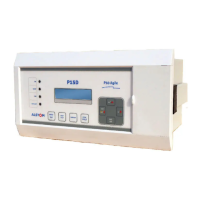
Do you have a question about the Alstom MiCOM P50 Agile P15D and is the answer not in the manual?
Key capabilities including protection, measurement, and HMI.
Detailed list of protection functions, HMI, communication, and I/O.
Describes USB and RS485 ports for data transfer and SCADA.
Guidelines for personnel working with electrical equipment and safety precautions.
Explanation of safety symbols used in the manual and on equipment.
Warnings regarding live parts, isolation, and protective barriers.
Specifies fuse types and ratings for auxiliary supply protection.
Guidance on terminal block connections, crimping, and wiring practices.
Essential checks before powering up the equipment for safe operation.
Details conformity with Electromagnetic Compatibility Directive.
Details conformity with Low Voltage Directive requirements.
States compliance with Underwriters Laboratories requirements for Canada and USA.
States ATEX directive compliance for operation outside hazardous areas.
Explains the main hardware components and their basic functions.
Lists specifications for the microcontroller and its memory.
Describes the relay's power supply options and internal circuitry.
Details the LCD display and touch keys for interacting with the relay.
Explains the function of the four high-intensity LEDs for status indication.
Describes the USB port's purpose for PC communication and firmware updates.
General procedure for modifying relay settings using the HMI.
Step-by-step guide for changing alphabetic and numeric parameters.
Outlines the main menu structure and available options for configuration.
Explains the role of IEDs in fault protection and overcurrent/earth fault principles.
Describes the function of thermal overload protection and its calculation.
Explains the purpose of undercurrent protection for power system stability.
Details the logic for preventing nuisance tripping during load energization.
Settings related to system frequency, communication port, and password.
Settings for controlling circuit breaker operations like Trip Test and Trip Block.
Configuration of local time, DST, and time synchronization parameters.
Management of different protection setting groups and their parameters.
Describes the logging of events, faults, and disturbances for system analysis.
Details how to view measured system quantities like current and thermal state.
Explains the relay's self-monitoring capabilities and error reporting.
Covers communication interfaces for remote monitoring and control via SCADA.
Describes the function and replacement of the non-rechargeable battery for parameter viewing.
Details the application of the MODBUS standard for communication.
Explains the use of IEC 60870-5-103 protocol for protection equipment communication.
Maps MODBUS function codes and IEC 60870-5-103 information numbers to device functions.
Requirements for receiving, unpacking, and storing the equipment safely.
Procedures and required equipment for testing and setting up the relay.
Guidelines for regular checks to ensure correct operation and integrity.
Information on identifying and resolving hardware or software faults.
Lists compliance with various international standards and directives.
Specifies current transformer secondary ratings, burden, and operating range.
Details auxiliary voltage ranges, burden, and interruption handling.
Describes the characteristics of the relay's output contacts, including capacity and timing.
